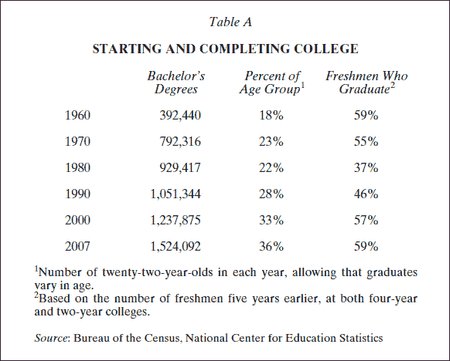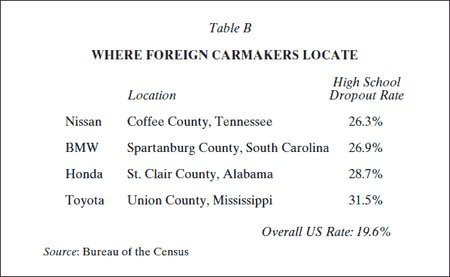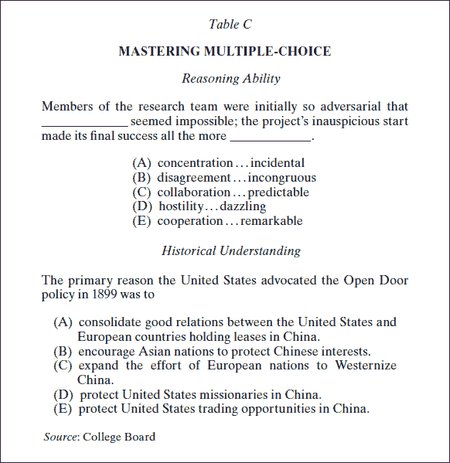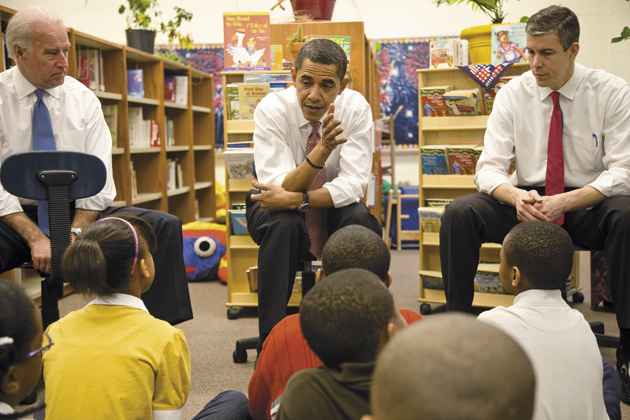1.
However the current economic crisis is resolved, the future living standard of Americans will turn on how productive we are and how much other countries will want what we create. The challenge goes beyond restructuring institutions. More crucial is whether we will be astute enough to hold our own in a world more competitive than we have ever known.
During its first two centuries, this country seemed slated to gain and then maintain global preeminence. Reasons often cited were a political system congenial to an open economy, infusions of immigrants, and the continent’s abundant resources. Claudia Goldin and Lawrence Katz, two Harvard economists, have a different explanation. In their new book, The Race Between Education and Technology, they contend that what distinguished the United States was that it became the world’s most educated nation. They combine an acute sense of history with a skillful use of statistics. Thus they note that in the Jacksonian era, access to education opened as “common schools” ceased charging fees. After the Civil War, school attendance and hence literacy became compulsory, creating a more agile and adaptive workforce. Over the decades that followed, “education became the dominant factor determining the wealth of nations.” While Goldin and Katz are hardly the first to focus on human capital, they specify that in America, these assets were fostered by lessons learned in classrooms.
Their principal thesis is that new technologies can bring advances in productivity only if they are matched by a workforce able to operate new kinds of machines. After all, little is gained by installing state-of-the-art equipment if no one nearby can make it work. Thus Golden and Katz conclude that it is added years of schooling that “facilitate the adoption and diffusion of new technologies.” Even early in the last century,
high school graduates were sought because they could read manuals and blueprints, knew about chemistry and electricity, could do algebra and solve formulas, and, we surmise, could more effectively converse with the professionals, such as chemists and engineers, in high-technology industries.
For our own time, they argue, a higher level of education is needed. To start, they say more people should be pursuing degrees in science and engineering—they cite cellular biology and nanotechnology in particular—where other countries are surpassing us. But since many occupations require sophisticated skills, they also want to see an increase in general college enrollments, which they say have been slowing.
Like most economists, Golden and Katz rely on what can be closely measured: output per labor hour, income differentials, diplomas awarded, capital investment. They deploy upward of a hundred tables, based on mathematics many readers will have to take on faith. Yet important human stories emerge from their logarithms and regressions. They note, for example, that workers “become smarter” as they learn to operate sophisticated equipment. (Marx comes to mind : “the laborer is brought face to face with the intellectual potencies of the material process of production.”) New technologies become our teachers, at least for those prepared to learn.
While their book is filled with interesting material, I am uneasy with its basic premises. For example, as they read the figures, a “slow-down in college-going” began in the 1980s and is still continuing. As a result, there are fewer workers with the skills that are normally acquired through higher education, which has in turn impelled employers to offer higher salaries for those having degrees. Therefore more money has been lofted upward, widening the gap between the college class and everyone else. (This persists in dire economic times such as the present, although incomes for college graduates have declined slightly in recent years: blue-collar unemployment is now over twice that for workers who have completed college.) The closing chapter of The Race Between Education and Technology calls for opening higher education to more Americans, which will mean making it possible for many people from lower-income brackets to go to college, so that the economy can gain from their abilities and also diminish disparities in earnings.

In fact, there’s only been a “slowdown in college-going” to the extent that annual growth in the number of degrees conferred is not as great as it was in the past. But we can’t expect to replicate the doubling of degrees that occurred in the 1960s. What is evident from Table A is that the pool of Americans graduating from college has been increasing without a break. Moreover, since 1980, the proportion of freshmen who finish has also grown from just 37 percent to nearly 60 percent. Currently, fully two thirds of Americans of college age actually start in four-year schools or two-year programs.
Many in the other third are qualified for college, but the barriers to attending are not as linked to ability to pay as one might think. Most community colleges still charge less than $2,500 for a full year’s program. Tuition at regional state universities ranges from $3,790 in Florida to $8,424 in New Hampshire; but students often pay less because of Pell Grants and other subventions. (In fact, as a consequence of the economic crisis, enrollments at less-expensive state colleges are projected to increase dramatically in 2009.) The real problem is the 25 percent of teenagers who, according to the US Department of Education, don’t finish high school and those who graduate unprepared for basic college work.
Advertisement
Goldin and Katz are quite right in saying that the pay premium for completing college has widened. Back in 1960, the census found that the earnings of college graduates exceeded those with only a high school education by 39 percent; in 1980, that edge was 50 percent; and by 2007, it had grown to 68 percent. But if there’s been a bidding war, the payoffs have been relatively modest. If we look simply at men aged thirty-five to forty-four who have bachelor’s degrees, their median earnings in 2007 were slightly over $68,000 (which means half make less than that), with college-educated women that age receiving just over $48,000. In fact, the growing earnings gap has owed less to what graduates as a whole are making than to the outsized sums accruing to the very top tiers.1
As Goldin and Katz see it, attending college has discernible effects for those who decide to go; why else would graduates be avidly sought after and better paid? So I wish they had said more about how the college experience affects productivity. Compared with all degrees, the proportion of those given in engineering and the physical sciences is actually declining. Instead, more students are choosing what a professor of mine called “conversational occupations.” If current preferences continue, in the next ten years our universities will produce 430,000 new lawyers and 1.4 million new MBAs. Goldin and Katz realize this, which may be why they reframe their argument by saying more generally that “the skills that are in the greatest demand today are the analytical ones,” especially people “who can think abstractly.” But I’m not so sure that the modes of abstraction and analysis recently common to academe (postmodernism?) will help get the next generation of Apples and Googles started. Even as we want to support education, we should be wary of ascribing outcomes to it that are more fancied than actual.
When it comes to technology, in the past some of the greatest strides were made by men like Henry Ford, George Eastman, and Thomas Edison, who had minimal formal schooling. More recently, Larry Ellison (Oracle), Bill Gates (Microsoft), Steve Jobs and Steve Wozniak (Apple), and Michael Dell (on whose computer I’m writing) like recounting how they dropped out of college. They clearly have good minds, as attested by the enterprises they’ve built, but apparently they were no longer stirred by what professors wanted to teach them. Nor are the strengths of entrepreneurs like Gates and Jobs primarily technological. More crucially, they have an intuition for products people will feel they must have once they see them on the shelves.
2.
In view of Goldin and Katz’s concerns, it is relevant to ask if there is actu- ally a demand for more people with technology-linked degrees. Each year, the Bureau of Labor Statistics tallies how many men and women are employed in some 1,400 occupations, from aerobics instructors to zoologists. And biennially it prepares forecasts of how the job market will look a decade later. Its most recent Occupational Outlook Handbook uses payrolls for 2006 as a base, and then offers employment estimates for 2016.
I was surprised to learn that in 2006 the nation altogether had only 17,000 paid positions for physicists, apart from teachers, and that only 1,000 more openings are envisaged for 2016. The number of employed mathematicians is expected to rise from 3,000 to 3,300. (Of course, recessions put new jobs on hold; but we may hope that new hirings will be resumed by 2016.) Employment for engineers is slated to grow from 1,512,000 to 1,671,000, about the same percentage of growth as for the workforce as a whole. Indeed, at current rates, 650,000 new engineers will have received degrees by 2016, four times the predicted number of openings. Hence a high attrition rate. Most reach salary ceilings early—chemical engineers average $73,300 at midcareer—so many shift to sales or management.
Perhaps our society would benefit were we to train more people in science and technology. But no matter how estimable their knowledge, when employers say they don’t need more of these employees, it tells us either that there aren’t tasks for them to do, or that money isn’t there for other things they might be doing. Government-financed public works projects would increase openings in some scientific fields, although not necessarily in cellular biology. While updating our infrastructure will clearly aid the economy, it doesn’t necessarily bring innovations that will keep us competitive in the twenty-first century.2
Advertisement
Something more emerges from the Occupational Outlook Handbook. It lists hundreds of jobs involved with high-tech instruments, including installing, repairing, and debugging them. These workers outnumber college-trained scientists, and even engineers. Here are some of the things they do: gynecologic sonography, geodetic surveying, avionic equipment mechanics, semiconductor processing, air traffic controlling, laboratory phlebotomy, blood bank clinical work, cryptanalysis keying. Yet these technicians are most often only high school graduates, sometimes with community college credits. Moreover, the knowledge they need is acquired mainly on the job, because that’s where the equipment is. A former undergraduate of mine, who didn’t graduate, is fairly typical. She began as a secretary for a firm that sells endoscopic cameras to hospitals, and they saw that she had a talent for understanding the technical system that makes the cameras work. She now teaches surgeons twice her age how to use those instruments.3

Not all high-tech employers look for workers with degrees. By now, we can agree that European and Asian carmakers have taken the lead in using computer chips for ignition timing, fuel injection, and cylinder control. These devices must be expertly installed. And they are, by hourly workers on the assembly line. That noted, Table B shows where four representative firms decided to locate American plants. True, they look for states that offer tax waivers, are unwelcoming toward unions, and have pay rates below the national norm.4
But it apparently hasn’t bothered BMW and Toyota that the counties they chose offer less-than-stellar schooling. Rather, they’ve found that even workers who were indifferent students can learn what’s needed technically in the factory, as happens in the companies’ home countries.
Goldin and Katz state their goal at the start: “we want to know the direct effect of education on economic growth.” And by the end they feel they’ve found that effect. I’ll grant that their correlations show that education and economic growth have risen in tandem. But it just might be that the causation runs the other way. As the production of goods and services becomes more efficient, not only does national wealth increase, but there is less need for teenage labor. So society finds itself able to underwrite more schools and colleges, and keep more young people in them longer. Indeed, several years on a college campus is an amiable interlude; many recall it as the best time they’ve known. Moreover, much of the original funding of higher education came from the profits of innovative industries headed by figures like Cornelius Vanderbilt, Leland Stanford, James Duke, and Ezra Cornell. It’s noteworthy that their endowments emphasized the liberal arts, not technological education.
3.
If Goldin and Katz feel that we are not sending enough young people to college, Charles Murray thinks that too many are already there and their numbers should be cut back. “How smart do you have to be to cope with genuine college-level material?” he asks in Real Education: Four Simple Truths for Bringing America’s Schools Back to Reality, so that he can answer, “No more than 20 percent of students have that level of academic ability, and 10 percent is a more realistic estimate.” Were we to reduce enrollments to the latter figure, we would be back to the attendance ratio of 1940.
Higher education, at least if set at Murray’s standard, “is intellectually too demanding for most young people.” In Murray’s view, you need 590 on the SAT Verbal and 610 on Math to be a passable college student. As evidence, he quotes paragraphs from several college textbooks, mainly from the 1970s and 1980s. By his count, their sentences average twenty-six mostly multisyllabic words. As in this clause: “an intellectually imperious procedure that has produced an existential and cultural impoverishment.” Here Murray is right; most of today’s freshmen would find such prolixity beyond them until a teacher gave them some help. But they needn’t worry. Instead, he reports, they can enroll in “The History of Comic Book Art” at Indiana University, or “Ghosts, Demons, and Monsters” at Dartmouth.
He says nothing about vocational majors, which over half of undergraduates now pursue. But I suspect he feels that programs like sports management, fashion merchandising, and ornamental horticulture don’t belong in colleges or merit receiving degrees. How about engineering? It clearly isn’t an easy concentration, as vouched for by its high dropout and failure rates. From what I’ve seen, textbooks in petrochemistry are more demanding intellectually than the quoted passage on existential impoverishment.
This is, of course, the Charles Murray of The Bell Curve. So when he speaks of a lack of “academic ability,” he doesn’t mean inadequate preparation. After all, that could be remedied by improving teaching or sending students to better schools. Rather, his view is that only 10 to 20 percent of a population has the mental potential to cope with twenty-six-word sentences.

His position is that capacity for college work is genetic, and hence inherited. If both your parents have degrees, you’re more likely to do well at college; even granting that there will be diamonds in the rough, as well as low achievers in high-intellect families. Murray calls this potential a “general mental factor,” and he believes it can be pinpointed by SAT scores. Considering his commitment to subjects like philosophy, history, and literature, I find it bemusing that he is so ready to use tests with standardized questions and answers (some typically superficial examples are in Table C) to decide who is college material. Sadly, he is not alone in feeling that multiple-choice responses are reliable measures of academic promise, and he doesn’t discuss the literature showing their limitations.
4.
In view of the huge numbers of students applying to college, technology designed to sort them out seems indispensable. This year, Harvard’s undergraduate college received 29,112 applications. (If a typical folder is a half an inch thick, upright these folders would stretch over four New York City blocks.) In Harvard’s case, they must first decide how to begin the culling for an intake of only 1,632 students, especially when most candidates have A averages and glowing recommendations. Enter the aforementioned SAT, where all applicants confront the same questions, and algorithms are used to create a spread of scores. Selective schools have found that inscribing SAT scores on the top of each folder makes for the most efficient winnowing, starting with the perfect 1600s and working through the pile. After that, attention can be turned to lacrosse goalies, viola players, and would-be poets.
The sway of the SAT has come under criticism, largely because it is so schematic; so those who rely on it have felt obliged to respond. Hence we have a report on the subject by a panel headed by William Fitzsimmons, Harvard’s admissions dean, with most of its other members holding similar positions. (Oddly, neither teachers nor professors were invited.) The report shows how SAT scores have gained a life of their own. The authors deplore the U.S. News college rankings, which, for all their imperfections, command wide attention. A variant of the SAT decides who gets National Merit Scholarships; fewer go to women because scores on the mathematics section are given decisive weight, whereas women tend to score better on the verbal section. Even rating services like Moody’s use SATs in calculating the credit standing of college bonds.5
The SAT has long claimed to be an objective assessment of aptitude, rather than achievement. That is, a young woman from rural Arkansas who had never heard of the test could sit down and take it, and it would reveal her academic potential. The Fitzsimmons panel comes close to accepting this view, since it is unwilling to grant that special help can raise scores more than marginally. Students report otherwise, especially those who take the SAT twice, with a coaching course in between. And this explains why test preparation is a $1 billion business, led by the Kaplan company, owned by The Washington Post, and Princeton Review, not affiliated with the university, even if some of its clients think it is. The classes offered don’t try to enlarge your vocabulary or improve your algebra. Rather, they focus on the test’s format: mastering the ways multiple-choice questions are posed and learning how guessing can pay off. Kaplan charges about $1,000 for twelve Sunday sessions. Princeton Review asks up to $9,500 for twenty-five at-home meetings with a tutor.
The Fitzsimmons group’s chief proposal is to move away from the basic SAT, because the general mental ability it purportedly measures is not, they conclude, calibrated for what college will require. In its place, they would have students take the SAT’s “subject tests” in fields like history, the sciences, and languages. At first glance, this makes sense. But questions in such tests seem more attuned to Thomas Gradgrind (“Facts. Teach these boys and girls nothing but Facts”). Since the method the commission favors is still multiple-choice, Kaplan and Princeton can show you how to outwit at least a good many of the questions. True, substantive knowledge is essential, and we’d like freshmen to be familiar with the Open Door policy of 1899, and in mathematics there’s no substitute for the ability to solve an equation. But for many fields of knowledge, the pick-one-from-five model, now used from third grade through graduate school admissions, replaces analysis with factoids, and with dexterity in divining which answers the testmakers have decided are correct.
5.
Being able to pay for coaching clearly helps in raising scores and hence admission to colleges with high SAT cutoffs. But income isn’t always the decisive factor. If we single out students from families with household incomes of, say, $70,000 to $80,000, the SAT scores of black students average 170 points below those of whites and Asians. In Taming the River, Camille Charles and her colleagues feel that an explanation of this disparity is needed. Charles’s book (I’ll cite only her, since she is the lead author) is a study of 3,924 students of varied ethnicities in twenty-eight colleges, ranging from Stanford and Princeton to huge state universities. A typical finding is that 84 percent of the black students accepted by these schools had SAT scores below the midpoint of their future classmates.
The book’s most striking chapter centers on what Charles calls “the neural chemistry of learning.” “Chronic exposure to stress,” she tells us, “signals the pituitary gland to release adrenocorticotripic hormone.” This happens more often with black students if they are raised “in a segregated environment characterized by high levels of disorder and violence.” The result can be
cognitive impairments capable of undermining academic performance in important but subtle ways years later…that appear to have depressed their performance in the SAT.
So, according to Charles, even black students not raised in inner cities, like many in the $70,000-to-$80,000 bracket, experience indirect stresses with “effects on cognition,” and hence their SAT gap. Charles also says that for those raised in Black English Vernacular, “learning to speak the language of the college classroom is equivalent to mastering a second language.” I’m wary of such generalizing. On my municipal campus, I’ve found that the black students who reach a college track understand standard pronunciation and grammar without any obvious difficulty. The problem is less in pituitary glands than in living in settings where buckling down to do schoolwork calls for remarkable determination. Plus that being black in America—which isn’t chemical—can take a psychological toll even in seemingly secure locales.
As it turns out, black students account for only 7 percent of the enrollments in Massey’s twenty-eight selective schools. Of course, there should be concern over academic preparation and performance; but I doubt if neural chemistry is the key. Indeed, we know a lot about what needs to be done, starting with preschool education and going on to give close attention to each student’s situation in the early phases of learning.6
But numerically, white students dominate most campuses, comprising 73 percent of those receiving four-year degrees. Since Goldin and Katz are counting on colleges to ensure the nation’s future, it’s worth taking a closer look at this larger but hardly studied ethnic group.
About twenty years ago, white students started being displaced by Asians at competitive schools, owing to Asians’ superior academic records. Asians now average 12 percent of the enrollments at Charles’s twenty-eight colleges, three times their share of the college-age population. Their enrollments are as high at 18 percent at Emory and 24 percent at Stanford. And this despite the fact that not even a third of them have English as their first language. There is reason to believe that the ratios of Asian students would be greater if colleges considered only academic achievement.7 I have seen no clear explanation of their success; but these students often come from close-knit, hardworking families who have conquered obstacles to come to America and to make a living here, and have high expectations of their children.
Among white applicants who are accepted to college, growing numbers have been flagged for prowess in sports like ice hockey and lacrosse, as well as golf and tennis, which they started playing in suburban and private schools. Students chosen for these teams—we’re not talking about football or basketball—also have weaker academic credentials and are less apt to take part in the studious side of college.8 Offspring of alumni, who up to now have been almost entirely white, also benefit from a version of affirmative action. And as with athletes, their presence affects the quality of the student body. That the children of graduates need preferment suggests they may not be as talented as their parents; but it’s hardly news that many scions of the successful regress to the mean. This decline is especially marked among white men of college age. Whereas 47 percent of white women now complete bachelor’s degrees, only 36 percent of white men do.
The skills that Goldin and Katz want taught and learned are obviously important. But ultimately, ingenuity and imagination are more consequential than formal schooling. Recently, those traits have been applied to “products” like securitized mortgages, credit swaps, and sequestering profits abroad. Now it’s time to turn such talents to novel forms of energy, new generic drugs, even fast foods compatible with a long life. The abilities to achieve these goals are not likely to be uncovered by multiple-choice tests. At issue is not whether we will again lead the world, but whether we can make a large contribution to its well-being.
This Issue
April 30, 2009
-
1
See Stephen Kotkin, “Minding the Inequality Gap,” The New York Times, October 5, 2008. ↩
-
2
See Everett Ehrlich and Felix G. Rohatyn, “[A New Bank to Save Our Infrastructure](/articles/archives/2008/oct/09/a-new-bank-to-save-our-infrastructure/),” The New York Review, October 9, 2008. ↩
-
3
Americans with “some college,” but who have not graduated, are too often overlooked. In November 2008, they comprised 28 percent of the workforce, nestled between the 35 percent who had degrees and the 37 percent with high school or less. ↩
-
4
See James Lardner, “[The Specter Haunting Your Office](/articles/archives/2007/jun/14/the-specter-haunting-your-office/),” The New York Review, June 14, 2007. ↩
-
5
There is also the American College Test, which in 2008 was taken by 1,421,941 students, not far behind the 1,518,859 sitting for the SAT. More selective colleges say they prefer the SAT, and students take the hint. Many feel it prudent to turn in both tests. ↩
-
6
See James P. Comer, Leave No Child Behind (Yale University Press, 2004), for a description of his programs, which emphasize close involvement with parents. See also James J. Heckman, Investing in Disadvantaged Young Children Is an Economically Efficient Policy, presented at the Committee for Economic Development/Pew Charitable Trusts/PNC Financial Services Group Forum on “Building the Economic Case for Investments in Preschool,” New York City, January 10, 2006. ↩
-
7
At Berkeley, UCLA, and Irvine, Asian students now outnumber whites. UCLA’s initials are now reputed to stand for Unhappy Caucasians Lost among Asians. ↩
-
8
A study of 124,374 applicants at ten selective colleges found that 50 percent of athletes were admitted, as were 46 percent of legacies, as opposed to 22 percent of the general pool. See Thomas J. Espenshade and Chang Y. Chung, “The Opportunity Cost of Admission Preferences at Elite Universities,” Social Science Quarterly, June 2005. ↩



